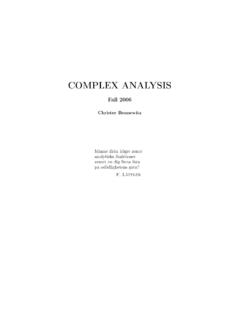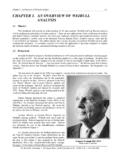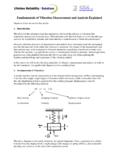Transcription of Why To Study Finite Element Analysis - ADINA
1 Why to Study Finite Element Analysis ! That is, Why to take Klaus-J rgen Bathe Why You Need to Study Finite Element Analysis ! Klaus-J rgen Bathe Analysis is the key to effective designeffective design fluid flows (with or without heat transfer)We perform Analysis for: deformations and internal forces/stresses temperatures and heat transfer in solids fluid flows (with or without heat transfer) conjugate heat transfer (between solids and fluids) An effective designeffective designis one that: performs the required task efficiently is inexpensive in materials used is safe under extreme operatinis safe under extreme operating conditions can be manufactured inexpensively is pleasing/attractive to the eye AnalysisAnalysismeans probing into, modeling, simulating naturesimulating natureTherefore, analysisanalysis gives us insight intogives us insight intothe world we live in,the world we live in,and this Enriches Our life Many great philosophers were analysts and engineers.
2 AnalysisAnalysisis performed based upon the laws of mechanicsmechanicsMechanics Solid/structural mechanics (Solid/structural dynamics) Fluid mechanics (Fluid dynamics) Thermo mechanics (Thermo dynamics) Solution ofThe process of Analysis Physical problem (given by a design ) Mechanical model Improve model Change of physical problem Solution of mechanical model Interpretation of results Refine Analysis Design improvement Analysis of helmet subjected to impact New Helmet Designs CAD models of MET bicycle helments removed due to copyright of helmet impact Laboratory Test Head ADINA Simulation Model Helmet Anvil Analysis of helmet subjected to impact Comparison of computation with laboratory test results In engineering practice, Analysis is largely performed with the use of Finite Element computer programs (such as NASTRAN, ANSYS, ADINA , SIMULIA, ) desi n CADro rams CatiaThese Analysis programs are interfaced with computer-aided design (CAD) programs Catia,g ( ) p g , SolidWorks, Pro/Engineer, NX, etc.
3 The process of modeling for Analysis The process of modeling for Analysis (continued) 2-D solidHierarchical modelingHierarchical modelingMeans taking increasingly more complex models to simulate nature with increasing accuracy Increasingly more Assumptions:Assumptions:spring, rod, truss beam, shaft complex models 2-D solid plate shell fully three-dimensional dynamic effects nonlinear effects naturenatureCAD and Analysis In CAD System CAD solid model is established In Analysis System Preparation of the mathematical model Meshing and Solution Presentation of results CAD model of missile Finite Element Representation Pump Finite Element Representation Number of equations 1,040,049 Pump Engine block - photo Courtesy of AB Volvo Penta. Used with permissionEngine block - mesh Courtesy of AB Volvo Penta.
4 Used with permissionfor a reasonable Finite Element -alwa siveyg,A reliable and efficient Finite Element discretization scheme should - for a well-posed mathematical model -always give, for a reasonable Finite Element mesh, a reasonable solution, and - if the mesh is fine enough, an accurate solution should be obtained -and meshin usedgElement Selection We want elements that are reliable for any - geometry - boundary conditions -and meshing used The displacement method is not reliable for - plates and shells - almost incompressible Analysis Schematic solution results Example problem: to show what can go wrong six frequencies (in Hz) of 16 Element mesh Consistent mass matrix is used 16el. model 16el. model 16x64 Element model Mode Use of 3x3 Use of 2x 2 use of 3x3 Gauss number Gauss int egration Gauss int egration int egration 1 2 3 4 154 8 * 1441 5 2654 1528 2345 6 2691 2602 2664 *Spurious mode (phantom or ghost mode) Ref: Finite Element Procedures (by K.)
5 J. Bathe), Prentice Hall, 1996 Some Analysis experiences analysesTremendous advances have taken place mixed optimal elements have greatly increased the efficiency and reliability of analyses sparse direct solvers and algebraic multigrid iterative solvers have lifted the Analysis possibilities to completely new levels lar e civil en ineerin structuresIn Industry: Two categories of analyses Analysis of problems for which test results are scarce or non-existent large civil engineering structuresg g g Analysis of problems for which test results can relatively easily be obtained mechanical / electrical engineering structures Seismic anal sis of ma or brid esyjgExamples of category 1 problems Analysis of offshore structures Seismic Analysis of major bridges only "relatively small" components can be tested Reliable Analysis procedures are crucial Holand, "Lessons to be learned fromSleipner platform Recall the catastrophic failure in 1991 of the Sleipner platform in the North Sea Ref.
6 I. Holand, "Lessons to be learned from the Sleipner accident" Proceedings, NAFEMS World Congress '97, Stuttgart, Germany, April 1997. Probabl due to the Slei ner accidentyp,Heidrun platform The world's largest of its kind (in 1997) Probably due to the Sleipner accident, increased Analysis attention was given to critical components designers and analysts worked closely together Accuracy - part of reality Coarse Mesh Converged Mesh Reference Mesh Correct surface stress prediction at critical locations is of vital importance for fatigue life determination Seismic Analysis of major California bridges Damage from the 1989 and 1994 earthquakes Objective is to retrofit / strengthen the bridges (including the famous San Francisco-Oakland Bay Bridge)
7 Photo by Luis Alberto by of category 2 problems Metal forming, crash and crush analyses in the automobile industries These types of problems can now be solved much more reliably and efficiently than just a few years ago Roof crush Analysis Roof crush Analysis Roof crush Analysis ADINA Roof crush Analysis Material model: slab aluminum, elastic-plastic material roll rigid Rolling Multi-pass rolling ADINA : static, implicit Analysis slab 2160 u/p (4-node) elements , plastic-multilinear material model roll 360 rigid contact segments contact algorithms constraint-function Rolling multi pass rolling Initial mesh Final mesh Rolling Bumper reinforcement bumper reinforcement (steel) molding (plastic) Bumper cross-section Image from the Open Clip Art reinforcement pad upper binder initial blank deformed sheet punch lower binder Stamping on a single action press, springs provide constant holding force Bumper reinforcement Material data.
8 Steel, mm friction coefficient, = ADINA static, implicit Analysis 2750 MITC elements , 4-nodes plastic-multilinear material model rigid-target contact Bumper reinforcement Effective plastic strain distribution Bumper reinforcement Final thickness distribution Fluid-flows fully-coupled with structural interactions an increasingly important Analysis area Full Navier-Stokes equations for incompressible or fully compressible flows Arbitrary Lagrangian-Eulerian formulation for the fluid Shock absorber Shock absorber Assembly parts Shock absorber Structural model Shock absorber Fluid mesh Shock absorber Shock absorber e e onSpecular Radiation Model Lens Direct Filament Radiation Specular R fl cti Transmission & Absorption Bulb Reflector Power Input Reflection Bulb Absorption & Re-Radiation Filament Lamp Internal Air Volume Mesh
9 200,000 Tet elements Smooth Transitioning Localized Mesh Refinement Lens Temperature *> F MeasuredPredicted Max *< F Max 211 Signal Housing Temperature *> F MeasuredPredicted Max 256 Max *< F Exhaust Manifold Mesh Detail showing mesh mismatch Plot of effective stress in the solid Plot of pressure in the fluid Fuel pump Fuel pump Blood flow through an artery Solid mesh Fluid mesh Blood flow through an artery Blood flow through a stenotic artery Image by the National Heart, Lung, and Blood flow through a stenotic artery Analysis of an artificial lung Artificial Lung Courtesy of MC3. Used with flow inlet Blood flow outlet Fiber bundle exchange CO2 in blood with oxygen Flow separator Particle trace plot Analysis of an artificial lungParticle traceRadio-frequency tissue ablation Electrode Lesion Courtesy of Medtronic, Inc.
10 Used with tissue ablation Blood Electrode Catheter Tissue Symmetry face Radio-frequency tissue ablation Temperature variation during ablation cycle So, why Study Finite Element Analysis ? because - You learn modern Analysis techniques used widely in engineering practice and the sciences You learn how to establish computational models of problems of solids and fluids, solve them on a laptop, and assess the accuracy of the results You capitalize on your knowledge of mechanics, reinforce your knowledge, and solve problems that can only be tackled numerically on the computer Great knowledge in your toolbox whatever your goals! MIT / Finite Element Analysis of Solids and Fluids I Fall 2009 For information about citing these materials or our Terms of Use, visit.








